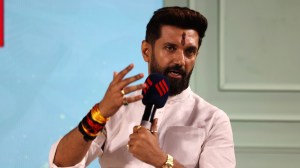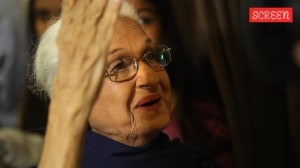Auteur in His Labyrinth
Nearly four decades into filmmaking,Gopalakrishnan gets his first biography an authorised one written by Gautaman Bhaskaran,with the title, Adoor Gopalakrishnan A Life in Cinema....
What is common between Nero and Adoor Gopalakrishnan? Clue: they both had difficult births. Born by breech delivery,they arrived in the world with their feet first. The former was self-absorbed in fiddling while Rome was burning; the latter,well,went on to make movies.
Nearly four decades into filmmaking,Gopalakrishnan gets his first biography an authorised one written by Gautaman Bhaskaran,with the title, Adoor Gopalakrishnan A Life in Cinema. The first chapter is,surprise,surprise,Feet on Earth,on how the breech baby was born,with his feet coming out first. That is why I have my feet on the earth, Gopalakrishnan says jocularly. Bhaskaran would brook no such levity; he quickly adds,and quite firmly too. Thereafter during each page turn,Bhaskaran invites the reader to watch with wonderment,the acts of Gopalakrishnan.
Consider this: a conventional turn-of-the-twentieth-century home of modest proportions where Adoor was born (the picture is given in the book),evokes,according to Bhaskaran,so much awe in passersby,that it reminded him of Chennais fourteen-storey Life Insurance Corporation building.
Or this: a character gluttonously eating out of a banana-leaf full of food in Naalu Pennungal (Four Women),with attendant noises,is described as an example of the Masters supreme humour. Bhaskaran would think,the wit is so subtle and British. (British? Whatever!) Grossness or otherwise lies in the eye of the authorised biographer.
Auteur is what Bhaskaran calls Gopalakrishnan. But Bhaskaran paints Gopalakrishnan more like a self-absorbed control freak. Two things,alas,remained out of his control: the audience,and rodents in films like Elipathayam (The Rat Trap). Gopalakrishnan did win the battle against the rats. Bhaskaran admiringly calls him,the Pied Piper of Kerala.
In the context of Malayalam Cinema,Bhaskaran portrays Gopalakrishnan peerless,and almost sui generis. His statement that G. Aravindans Uttarayanam emerged from the Chitralekha Film Cooperative stable,founded by Gopalakrishnan and others,is a terminological inexactitude; heck,a lie. The late Pattathuvila Karunakaran produced the film and it was shot,far away from Thiruvananthapuram,in the northern Kerala.
If the gentle reader wonders,has not the time come for throwing away the book,the answer is,yes,it has. Out goes the marionette through the window,and we train our attention on the ventriloquist. In writing this book Mr. Gautaman Bhaskaran has mostly depended on my talk, says Gopalakrishnan.
After Swayamvaram,Gopalakrishnans next film,Kodiyettam (The Ascent) was a commercial success,encouraging private producers to invest in him. The next film Elipathayam (The Rat Trap) was in colour and drew obvious parallels between a trapped rat and the protagonist. Mukhamukham (Face to Face) infused Gopalakrishnan with a new creative energy; from the vigorous opposition he received from the communists. The film dealt with a common Malayalam theme of Loss of Innocence among Communists. In this film,Gopalakrishnan discovers his political fount of anti-communism. It sustained him for some time.
After the collapse of the Soviet Union,a huge creative crisis overtook artists who were driven by anti-Communism. The last movie that Gopalakrishnan made before the Berlin Wall fell was Mathilukal (The Walls). For the next couple of years after the film,Gopalakrishnan fell silent,trying probably to figure out life after Communism.
His next film,Vidheyan (The Servile),was based on a story by Paul Zachariah. It was the story of a feudal lord,Bhaskara Pateler,and Thommi,his slave. The case of a non-exploding dynamite stick in a temple pond drew the writer and the director to a slanging joust. In the Zachariah original,the dynamite goes off; but for Gopalakrishnan it is a damp squib. He explains this as the triumph of faith of the Hindu villagers. Orphaned by the sudden demise of Communism,did the rudderless director now reach out to the resurgent and militant Hindutva of the early 1990s? The writer cant be faulted in suggesting so; to his credit,Gopalakrishnan steered clear of any sectarian leanings,during the controversy,or after.
Perestroika did Adoor Gopalakrishnan in. His next four movies were all stuck in the past or were drawn from his own life. In Kathapurushan,the hero is born feet first. Gopalakrishnans films during the period reminds me of what the late Pauline Kael wrote in the 1950s,The auteur theory is an attempt by adult males to justify staying inside the small range of experience of their boyhood and adolescence….
If there was a case for reinvention,this was it. James Bond did it,Gopalakrishnan couldnt. And Gautaman Bhaskaran has no clue.
N.S. Madhavan is a Malayalam writer


- 019 hours ago
- 029 hours ago
- 0315 hours ago
- 0449 minutes ago
- 0515 hours ago





























